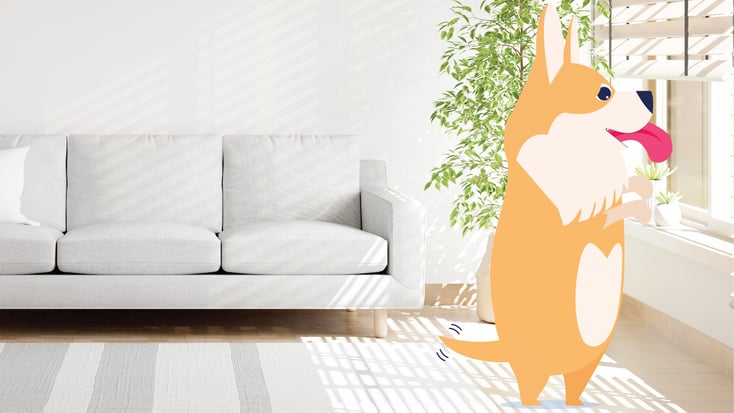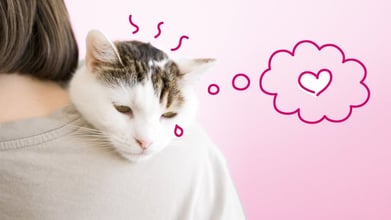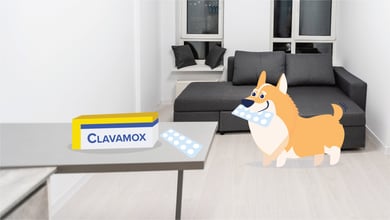Separation Anxiety in Dogs: 6 Ways You Can Help

Table of Contents
Separation anxiety is a complex and challenging set of behaviors to deal with, and most dog owners worry about their pets becoming upset or anxious when left alone. It’s thought that up to half of dogs suffering from separation anxiety don’t show any signs.
So, let's talk a bit more about separation anxiety and how to ensure your pet feels safe and relaxed when you leave the house.
Key Takeaways:
- Separation anxiety is a common condition where dogs feel stressed and unhappy when apart from their owners.
- Factors contributing to separation anxiety include lack of socialization, excessive alone time, fear, changes in the environment, the introduction of new pets or people, disruptions in routine, and boredom.
- Seek professional assistance if needed and consult a veterinarian for persistent issues.
What is Separation Anxiety in Dogs & Puppies?
Separation anxiety is a condition where dogs feel stressed and unhappy when they are apart from their owners. It often happens when dogs are not accustomed to being left alone or separated from their human family. Unfortunately, separation anxiety is a common issue, with around 8 out of 10 dogs experiencing difficulties when separated from their owners.
Related reading: Leaving a Puppy Alone at Home for the First Time
What Causes Separation Anxiety in Dogs?
We don’t know exactly why some dogs develop separation anxiety, but we know it can be triggered by several factors:
Here is a breakdown further explaining these different contributing factors:
Lack of early socialization
Not being left alone or with dog walkers/sitters during the puppy's crucial developmental stages can contribute to separation anxiety later in life.
Excessive alone time
Dogs need socializing and activities to stay happy. If they don't get enough of these, they may become anxious when their owners leave. Being alone for a long time can cause this anxiety.
Fear and lack of confidence
Dogs with a history of fear, insecurity, or limited exposure to different environments may develop separation anxiety as they rely on their owners for support and comfort in unfamiliar situations.
Changes in environment
Moving to a new home can trigger anxiety and insecurity in dogs, causing them to seek closer attachment to their owners for familiarity and reassurance.
Introduction of new pets
Adding a new pet to the household can disrupt the established routine and dynamics, increasing anxiety and clinginess towards the owner.
Disruptions in routine
Dogs thrive on consistency and can become anxious if there are frequent changes or disruptions to their daily routines, causing them to seek more dependence on their owners for stability.
Introduction of new people
The presence of unfamiliar individuals in the house can trigger anxiety in dogs, leading them to rely more on their owners for security and reassurance.
Boredom and lack of stimulation
Insufficient mental and physical exercise can result in boredom, restlessness, and energy channeling into anxious behaviors or attention-seeking actions.
Signs & Symptoms of Separation Anxiety in Dogs
Separation anxiety can differ in dogs, and some don’t show signs. Some of the most common symptoms of separation anxiety in dogs are:
- Whining, barking, or howling
- Pacing
- Trembling
- Excessive panting or yawning
- Drooling
- Destructive behaviors such as chewing furniture, scratching at doors, and ruining their toys
- Urinating or defecating around the house
- Ears back and their tail between the legs
Your pet’s mental health can be worrying, and it can often be tricky to spot the signs that something isn’t right, so it’s always important to consult your veterinarian. The symptoms of separation anxiety can also be signs of other medical problems, so it’s important to rule these out too.
How to Treat a Dog with Separation Anxiety
If you’ve welcomed a new puppy into your home in the past year, chances are he’s had the luxury of multiple potty breaks, long walks, and frequent belly rubs during the day. If one day, your 10-month-old puppy suddenly finds himself alone for the first time in his whole life, things may not go as smoothly as you’d like.
Slow acclimatization to new events in your pup’s life can make the transition easier for everyone involved. The best time to start is now!
1. Make gradual changes
If your puppy is going on four long, leisurely walks a day and you know you’re soon going only to have time for two somewhat shorter walks, make sure the transition isn’t a sudden one.
Gradually shave off 5 minutes at a time rather than suddenly cutting down on his much-loved walks. Similarly, if your puppy hasn’t known a room without you, slowly and gradually increase the time you’re away from home. Work your way up to longer separations.
Start by simply grabbing your jacket and keys while not actually leaving home and gradually progress to the point where you take short drives around the block. And remember to make your departure and return to ordinary events. Rather than lavish your pup with attention during these times, wait until he has calmed down before you greet him.
2. Reward alone time
Always reward your dog with something delicious and, ideally, time-consuming before you leave the house. Food puzzles, snuffle mats, and rubber chew toys stuffed with frozen treats can distract dogs during that crucial departure period; save the yummiest treats and the most interesting toys for these times.
The best food puzzles are durable and mentally challenging; you want your pup to be distracted and challenged by something besides your absence. Some food puzzles can function as slow feeders, gradually giving your dog his entire meal as he works out with his snout and paws how to extract that next bite.
3. Ensure their mental, emotional, and physical health
Before we settle on a diagnosis of separation anxiety, it’s important that we rule out other causes of your dog’s behavior. Is your puppy teething? Is he generally potty-trained but is now having accidents in the house?
Differentiating between normal behavior, illness, and separation anxiety may not always be straightforward. Ensuring your puppy’s mental and emotional health through training and socialization is a crucial step in helping him thrive on his own. Well-trained and well-socialized dogs are generally easier to communicate with and have healthy outlets for their boredom and stress.
Consider puppy training classes and work with your dog at home to “come,” “sit,” and “stay.” Ruling out medical causes for your dog’s unwanted behavior is also essential before a diagnosis of separation anxiety; make sure to have your puppy examined by a veterinarian regularly and any time he exhibits behavior that’s abnormal for him.
4. Make sure your puppy is safe
For some puppies and dogs, this means a crate with a comfy bed and their favorite toys. Yet others can hurt their paws, noses, and teeth trying to escape a crate. Every dog is different, and what works for one may be stressful for another; the key is to ensure your puppy can’t harm themselves while you’re away.
5. Consider natural supplements
Some dogs respond well to natural supplements designed to calm and soothe. Products containing dog-appeasing pheromones are formulated to mimic these naturally occurring soothing substances. These products come as diffusers that can be plugged into outlets or collars that are worn by your pup.
Other calming supplements formulated specifically for dogs may contain naturally derived products such as L-theanine, CBD, or alpha capsazepine.
6. Set up video surveillance
Watching how your puppy acts when you’re away can help you better assess his progress. Focusing a camera on the crate if your pet is contained or on the door if he’s free to wander will give you an idea of how he’s feeling throughout the day, how long it takes him to settle down, and how effective different treatment strategies are.
Conclusion
In conclusion, assisting your puppy in adjusting to being alone will require time and patience. Be kind to both your puppy and yourself during this transition. Seek assistance whenever possible, such as hiring a dog walker for mid-day exercise and socialization or consulting a veterinary behaviorist for hands-on guidance.
If the issues persist, don't hesitate to visit a veterinarian for further support.
Frequently Asked Questions
What's the difference between separation anxiety in dogs & normal behavior?
Separation anxiety in dogs is characterized by extreme distress and anxious behaviors when separated from their owners, while normal canine behavior includes being comfortable when left alone.
How can I prevent my dog from developing separation anxiety?
By getting your dog used to being left from a young age, they will become relaxed and confident without you. Always build this up slowly. Leaving your pet with a trusted sitter, daycare, or friend when you’re out can prevent them from becoming lonely. Ensure your pet gets a suitable diet and plenty of exercise to avoid boredom.
Do dogs eventually get over separation anxiety?
With proper training, environmental changes, and sometimes medication, dogs can overcome separation anxiety. However, the time it takes for a dog to recover from separation anxiety can vary depending on the individual dog and the severity of the anxiety.
Is separation anxiety in dogs curable?
Yes, with proper training, environmental changes, and sometimes medication, dogs can overcome separation anxiety.
Are certain dog breeds more prone to separation anxiety?
Some evidence suggests breed susceptibility to separation anxiety, but individual experiences and environment play significant roles.
Can other animals experience separation anxiety?
Yes, various animals, including cats and birds, can experience separation anxiety. Symptoms vary by species, so consult a veterinarian if behavioral changes occur.




